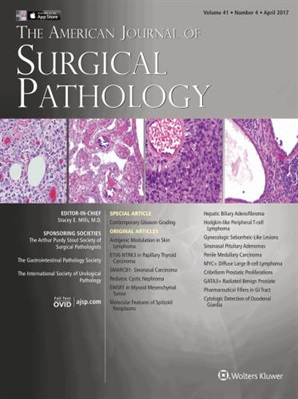上皮样纤维组织细胞瘤与浅表ALK排列肌样纺锤细胞肿瘤之间的关系:35例临床病理系列,包括RET和NTRK3交替融合。
摘要
无性淋巴瘤激酶(ALK)重排是大多数上皮样纤维组织细胞瘤(EFH)的驱动因素,据报道,在新出现的受体酪氨酸激酶(RTK)融合阳性间充质肿瘤家族中也存在无性淋巴瘤激酶(ALK)重排,其中包括以 "浅表ALK重排肌样纺锤形细胞瘤"(SAMS)为名的浅表肿瘤。在此,我们描述了35例具有SAMS形态的表浅肿瘤,其中18例为女性(51%),17例为男性,发病年龄中位数为39岁(6至82岁)。大多数肿瘤发生在下肢(25 例;71%),其次是上肢(5 例;14%)、躯干(3 例;9%)和面部(2 例;6%)。据报道,9例肿瘤在发病前生长缓慢,其中2例生长时间超过10年。肿瘤主要发生在真皮(32 例;91%)或皮下(3 例;9%);8 例真皮肿瘤延伸至皮下。肿瘤大小中位数为 1.3 厘米(范围:0.5 至 8.0 厘米)。12名患者(34%;范围:2个月至21年;中位数:2.7年)接受了临床随访,其中无一发生转移。一名未完全切除的肿瘤患者在 19 个月时局部复发,其他患者均未复发。从组织学上看,肿瘤的特征是平滑的纺锤形至卵圆形细胞呈轮状生长,基质为肌层至胶原层。复发特征包括表皮领带(19/30;63%)、血管周围透明化(20/35;57%)、淀粉样胶原(14/35;40%)和移行骨化(2/35;6%)。免疫组化(IHC)显示了ALK(24/31;77%)、CD34(15/21;71%)、EMA(17/28;61%)和S-100(9/32;28%)的表达。11例肿瘤表现出EFH和SAMS的混合形态特征;其中9例(82%)表现出典型的EFH细胞形态,但有轮状生长、肌样基质和/或纺锤形细胞形态区域。两个混合瘤在EFH特征区域和SAMS特征区域之间出现急剧转变,同时IHC显示EMA、CD34和S-100表达也出现急剧转变。测序结果显示,19 例肿瘤中有 15 例存在 ALK 融合:与 FLNA、SQSTM1 和 VCL 融合的各 2 例,与 COL1A2、DCTN1、EML4、FXR1、MPRIP、PLEKHH2、PRKAR1A、SPECC1L 和 TLN2 融合的各 1 例。通过 IHC 检测,14 例 ALK 重组肿瘤中有 13 例表达 ALK。3个ALK融合阴性的肿瘤携带交替RTK融合(NCOA4::RET、TRIM27::RET和VIM::NTRK3),1个肿瘤RTK改变阴性。在2个ALK融合的肿瘤和2个RET融合的肿瘤中发现了CDKN2A/B缺失。SAMS与EFH在形态学和分子遗传学上具有相同的谱系,分布在相似的身体部位,临床上常表现为外生性皮肤肿瘤,而且无一例外都是良性结果;我们的结论是,SAMS应被视为EFH的一种组织学变异。一些形态上的典型病例存在交替的 RET 和 NTRK3 融合,因此 SAMS 并不是这一形态类别的恰当名称;相反,为了突出与 EFH 在临床病理上的相似性,我们提出了 "上皮样纤维组织细胞瘤的肌样纺锤细胞变异型 "这一诊断术语。Anaplastic lymphoma kinase (ALK) rearrangements drive most examples of epithelioid fibrous histiocytoma (EFH) and have been reported in an emerging family of receptor tyrosine kinase (RTK) fusion-positive mesenchymal neoplasms, including superficial ones described under the rubric of "superficial ALK-rearranged myxoid spindle cell neoplasm" (SAMS). Here, we describe 35 superficial tumors with SAMS morphology, which occurred in 18 females (51%) and 17 males at a median age at presentation of 39 years (range: 6 to 82 y). Most tumors occurred on the lower extremity (25 tumors; 71%), followed by upper extremity (5; 14%), trunk (3; 9%), and face (2; 6%). Nine tumors were reported to have grown slowly before presentation, including >10 years in 2 cases. Tumors occurred primarily in the dermis (32 tumors; 91%) or subcutis (3; 9%); 8 dermal tumors extended into the subcutis. Median tumor size was 1.3 cm (range: 0.5 to 8.0 cm). Clinical follow-up was available for 12 patients (34%; range: 2 mo to 21 y; median: 2.7 y), none of whom experienced metastasis. One incompletely resected tumor recurred locally at 19 months, and no other patients experienced recurrence. Histologically, tumors were characterized by bland spindle-to-ovoid cells showing whorled growth and myxoid-to-collagenous stroma. Recurrent features included an epidermal collarette (19/30; 63%), perivascular hyalinization (20/35; 57%), amianthoid collagen (14/35; 40%), and metaplastic ossification (2/35; 6%). Immunohistochemistry (IHC) demonstrated expression of ALK (24/31; 77%), CD34 (15/21; 71%), EMA (17/28; 61%), and S-100 (9/32; 28%). Eleven tumors showed hybrid morphologic features between EFH and SAMS; 9 of them (82%) showed cytomorphology typical of EFH but with whorled growth, myxoid stroma, and/or regions of spindle cell morphology. Two hybrid tumors showed sharp transitions between a region characteristic of EFH and a region characteristic of SAMS, with a concomitant sharp transition in EMA, CD34, and S-100 expression by IHC. Sequencing revealed ALK fusions in 15 of 19 tumors: 2 each with fusion partners FLNA, SQSTM1, and VCL, and 1 each with COL1A2, DCTN1, EML4, FXR1, MPRIP, PLEKHH2, PRKAR1A, SPECC1L, and TLN2. Thirteen of 14 ALK-rearranged tumors expressed ALK by IHC. Three tumors negative for ALK fusions instead harbored alternate RTK fusions (NCOA4::RET, TRIM27::RET, and VIM::NTRK3), and 1 tumor was negative for RTK alterations. CDKN2A/B deletions were found in 2 tumors with ALK fusions and both tumors with RET fusions. SAMS is on a morphologic and molecular genetic spectrum with EFH, with a similar body site distribution, frequent clinical presentation as an exophytic skin tumor, and invariably benign outcomes; we conclude that SAMS should be considered a histologic variant of EFH. Some morphologically typical examples harbor alternate RET and NTRK3 fusions, such that SAMS is not an appropriate designation for this morphologic class; instead, to highlight the clinicopathologic similarities to EFH, we propose the diagnostic term "myxoid spindle cell variant of epithelioid fibrous histiocytoma."

 求助内容:
求助内容: 应助结果提醒方式:
应助结果提醒方式:


